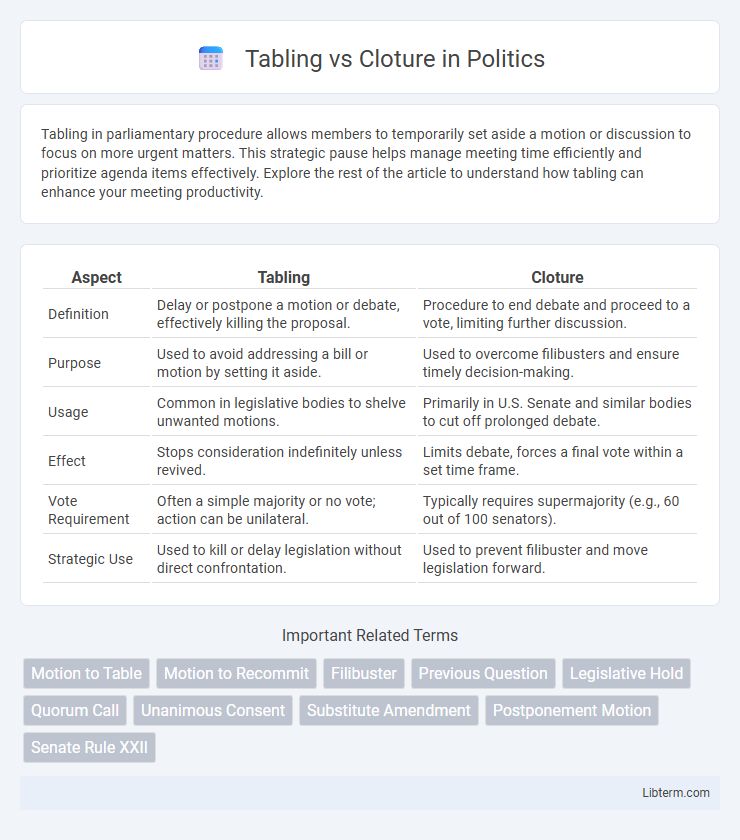Tabling in parliamentary procedure allows members to temporarily set aside a motion or discussion to focus on more urgent matters. This strategic pause helps manage meeting time efficiently and prioritize agenda items effectively. Explore the rest of the article to understand how tabling can enhance your meeting productivity.
Table of Comparison
| Aspect | Tabling | Cloture |
|---|---|---|
| Definition | Delay or postpone a motion or debate, effectively killing the proposal. | Procedure to end debate and proceed to a vote, limiting further discussion. |
| Purpose | Used to avoid addressing a bill or motion by setting it aside. | Used to overcome filibusters and ensure timely decision-making. |
| Usage | Common in legislative bodies to shelve unwanted motions. | Primarily in U.S. Senate and similar bodies to cut off prolonged debate. |
| Effect | Stops consideration indefinitely unless revived. | Limits debate, forces a final vote within a set time frame. |
| Vote Requirement | Often a simple majority or no vote; action can be unilateral. | Typically requires supermajority (e.g., 60 out of 100 senators). |
| Strategic Use | Used to kill or delay legislation without direct confrontation. | Used to prevent filibuster and move legislation forward. |
Understanding Tabling and Cloture
Tabling is a procedural action in legislative bodies where a motion or bill is set aside or postponed, effectively delaying further discussion without outright rejection. Cloture is a method used to end a filibuster or extended debate, requiring a specific number of votes to limit debate and proceed to a final vote. Understanding tabling and cloture is essential for grasping how legislative agendas are controlled and how debate is managed in parliamentary settings.
Historical Origins of Tabling and Cloture
Tabling and cloture have distinct historical origins rooted in parliamentary procedure evolution. Tabling, originating from British parliamentary practice in the 17th century, involved presenting documents for consideration, often leading to postponement or shelving of motions. Cloture, introduced in the U.S. Senate in 1917, was designed to end filibusters by limiting debate, marking a significant procedural innovation to ensure legislative efficiency.
Key Differences Between Tabling and Cloture
Tabling a motion in parliamentary procedure effectively delays or suspends consideration without setting a firm timeline, often used to manage or avoid debate. Cloture, in contrast, is a formal mechanism to end debate and force a vote, typically requiring a supermajority such as 60 votes in the U.S. Senate. While tabling pauses discussion indefinitely, cloture imposes a definitive cutoff, ensuring legislative progress.
The Purpose of Tabling in Legislative Procedure
Tabling in legislative procedure serves to temporarily suspend consideration of a motion or bill, allowing lawmakers to delay debate or avoid immediate voting. This strategic pause provides flexibility for gathering more information, negotiating terms, or defusing conflict within the assembly. Tabling differs from cloture, which is a formal action aimed at ending debate and proceeding to a vote.
How Cloture Ends Debate in Congress
Cloture ends debate in Congress by limiting further discussion and bringing a pending question to an immediate vote, typically requiring a supermajority of 60 senators. This procedure overrides a filibuster and ensures that the legislative process moves forward by setting a time limit on debate, usually 30 hours. Unlike tabling, which suspends consideration without debate, cloture actively curtails debate and forces a resolution.
Strategic Uses of Tabling and Cloture
Tabling and cloture are parliamentary tools used to manage legislative debate strategically; tabling a motion effectively delays or disposes of a bill without direct rejection, allowing opponents to pause legislation and regroup. Cloture ends extended debate by limiting further discussion and forcing a vote, used strategically to overcome filibusters and expedite decision-making. Legislators employ tabling to stall unwanted measures and use cloture to ensure timely passage of critical legislation.
Notable Examples of Tabling and Cloture in Action
Tabling motions have been notably used in the U.S. Senate to temporarily set aside controversial bills, such as the 2010 effort to table the health care reform legislation to delay debate. Cloture has played a critical role in ending filibusters, with the 1917 adoption of the cloture rule enabling the Senate to overcome prolonged debate during World War I. More recently, the 2013 "nuclear option" invoked cloture to confirm judicial nominees, illustrating its power to limit debate and advance legislative or confirmation processes.
Impact of Tabling vs Cloture on Legislation
Tabling a motion effectively delays or halts legislation, as it sets the bill aside without progressing to debate or vote, which can stall legislative processes indefinitely. Cloture, by contrast, limits debate and forces a timely vote on the bill, overcoming filibusters and expediting legislative decision-making. The strategic use of tabling can suppress controversial legislation, whereas cloture promotes legislative efficiency and finality.
Criticisms and Controversies Surrounding Tabling and Cloture
Tabling motions face criticism for their potential to indefinitely delay or suppress debate, often used strategically to avoid addressing contentious issues, which can undermine legislative transparency. Cloture, while designed to end filibusters and expedite decisions, is controversial for limiting minority rights by imposing time constraints on debate, sparking debates over the balance between efficiency and democratic deliberation. Both mechanisms attract controversy for their tactical use in parliamentary procedure, raising concerns about fairness, accountability, and the manipulation of legislative processes.
Future Trends in Parliamentary Procedure: Tabling and Cloture
Future trends in parliamentary procedure indicate a growing preference for cloture motions to efficiently limit debate and expedite decision-making, especially in legislative bodies facing increasing workload complexities. Advances in digital platforms are automating the tabling process, enhancing transparency and real-time tracking of motions. Legislative reforms also aim to balance the use of tabling as a stalling tactic with cloture to ensure timely resolution of critical issues.
Tabling Infographic

 libterm.com
libterm.com